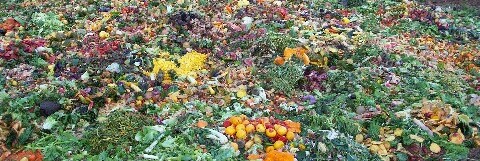Composting Florida’s Organic Materials

Source: Florida DEP
What are Organic Materials?
A very simple definition of organic is: pertaining to the vegetable or animal world. In nature, natural processes break down these materials into humus. These same processes are used to produce compost. As the conditions needed are optimized, the more quickly this product can be made.
The regulations governing composting of solid waste are found in Chapter 62-709, Florida Administrative Code (F.A.C). For purposes of these rules, compost is defined as solid waste which has undergone biological decomposition of organic matter, and has been disinfected using composting or similar technologies, and has been stabilized to a degree which is potentially beneficial to plant growth and which is used or sold for use as a soil amendment, artificial top soil, growing medium amendment or other similar uses. A mature compost bears little resemblance to the organic material it originated from.
Compost can be used in many ways such as a soil amendment, artificial topsoil or growing medium amendment. While compost contains some plant nutrients, it is not typically considered a fertilizer. Some benefits from using compost include retaining soil moisture and nutrients, improving soil aeration, returning nutrients to the soil, and suppressing soil-borne pests. Using compost products is considered recycling, and may be the oldest form of recycling.
Potential Volume
Backyard composting and in-situ grass clipping management should be encouraged as it is the best method for managing this waste. However, local governments must still manage large amounts of organic material. The compostable fraction in the municipal solid waste (MSW) stream includes food, paper and yard trash. Of the 23.8 million tons of MSW generated in the reporting period, the organic solid waste portion accounted for about 11.4 million tons, or 48 percent. If all this material was processed into usable compost, the yield would be about 5.7 million tons of compost. Yard trash alone accounts for 3.4 million tons, or 14 percent of the MSW stream. Per county annual reports, approximately 1.7 tons of yard trash or 7 percent of the MSW stream was processed into compost or mulch in 1997.
Composting Facilities and Department Policy
As of December 1998, there were 11 permitted composting facilities in Florida located in nine counties. (There was discussion about a research demonstration and development permit for a vermicomposting facility, however, a permit application was never submitted.) Except for the vermicomposting facility, these composting facilities utilize a windrow process at different turning frequencies, or an in-vessel treatment followed by a windrow process.
Compost Use in Florida
In fiscal year 1997-1998, the Department contracted with the Center for Solid and Hazardous Waste Management to develop a booklet, “Compost Use in Florida”, that addresses using compost in Florida. Along with general information, it includes research results from past projects. A copy may be obtained from the FDEP Solid Waste Section at (850) 488-0300.
This booklet is intended to distribute information gathered on the benefits for using compost to potential users to help assess the value of incorporating compost into their operations. This information includes benefits to citrus and vegetable crops, landscape and nursery industry, turfgrasses, forest lands and reclamation of phosphate mine lands. It not only helps point out to compost producers some of the characteristics that a particular industry may need, but also information that potential users need to be aware of when considering using compost.
Posted in: Uncategorized
Leave a Comment (0) ↓